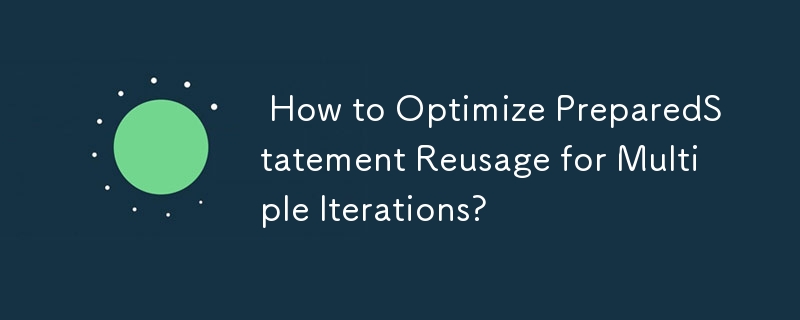How to Optimize PreparedStatement Reusage for Multiple Iterations?

Reusing a PreparedStatement with Multiple Iterations
In cases where a single, common connection is employed without a connection pool, you may encounter the question of whether it is more efficient to create a new PreparedStatement instance for each DML or SQL operation while preserving the benefits of prepared statements.
Instead of:
<code class="java">for (int i=0; i<1000; i++) {
PreparedStatement preparedStatement = connection.prepareStatement(sql);
preparedStatement.setObject(1, someValue);
preparedStatement.executeQuery();
preparedStatement.close();
}You may consider:
<code class="java">PreparedStatement preparedStatement = connection.prepareStatement(sql);
for (int i=0; i<1000; i++) {
preparedStatement.clearParameters();
preparedStatement.setObject(1, someValue);
preparedStatement.executeQuery();
}
preparedStatement.close();While the second approach offers a slight efficiency gain, a superior solution lies in batch execution:
<code class="java">public void executeBatch(List<Entity> entities) throws SQLException {
try (
Connection connection = dataSource.getConnection();
PreparedStatement statement = connection.prepareStatement(SQL);
) {
for (Entity entity : entities) {
statement.setObject(1, entity.getSomeProperty());
// ...
statement.addBatch();
}
statement.executeBatch();
}
}</code>This approach takes advantage of batching capabilities provided by JDBC drivers, reducing the number of round-trips to the database and increasing efficiency. You can further optimize by defining a batch size limit, such as executing every 1000 items:
<code class="java">public void executeBatch(List<Entity> entities) throws SQLException {
try (
Connection connection = dataSource.getConnection();
PreparedStatement statement = connection.prepareStatement(SQL);
) {
int i = 0;
for (Entity entity : entities) {
statement.setObject(1, entity.getSomeProperty());
// ...
statement.addBatch();
i++;
if (i % 1000 == 0 || i == entities.size()) {
statement.executeBatch(); // Execute every 1000 items.
}
}
}
}</code>As for multithreaded environments, you can ensure thread safety by acquiring and closing both the connection and the statement within the shortest possible scope using the try-with-resources statement, as demonstrated in the code snippets above. For transactional batches, disable autocommit and commit the transaction only after all batches have completed.
The above is the detailed content of How to Optimize PreparedStatement Reusage for Multiple Iterations?. For more information, please follow other related articles on the PHP Chinese website!

Hot AI Tools

Undresser.AI Undress
AI-powered app for creating realistic nude photos

AI Clothes Remover
Online AI tool for removing clothes from photos.

Undress AI Tool
Undress images for free

Clothoff.io
AI clothes remover

AI Hentai Generator
Generate AI Hentai for free.

Hot Article

Hot Tools

Notepad++7.3.1
Easy-to-use and free code editor

SublimeText3 Chinese version
Chinese version, very easy to use

Zend Studio 13.0.1
Powerful PHP integrated development environment

Dreamweaver CS6
Visual web development tools

SublimeText3 Mac version
God-level code editing software (SublimeText3)

Hot Topics
 1359
1359
 52
52
 How do I implement multi-level caching in Java applications using libraries like Caffeine or Guava Cache?
Mar 17, 2025 pm 05:44 PM
How do I implement multi-level caching in Java applications using libraries like Caffeine or Guava Cache?
Mar 17, 2025 pm 05:44 PM
The article discusses implementing multi-level caching in Java using Caffeine and Guava Cache to enhance application performance. It covers setup, integration, and performance benefits, along with configuration and eviction policy management best pra
 How can I implement functional programming techniques in Java?
Mar 11, 2025 pm 05:51 PM
How can I implement functional programming techniques in Java?
Mar 11, 2025 pm 05:51 PM
This article explores integrating functional programming into Java using lambda expressions, Streams API, method references, and Optional. It highlights benefits like improved code readability and maintainability through conciseness and immutability
 How does Java's classloading mechanism work, including different classloaders and their delegation models?
Mar 17, 2025 pm 05:35 PM
How does Java's classloading mechanism work, including different classloaders and their delegation models?
Mar 17, 2025 pm 05:35 PM
Java's classloading involves loading, linking, and initializing classes using a hierarchical system with Bootstrap, Extension, and Application classloaders. The parent delegation model ensures core classes are loaded first, affecting custom class loa
 How can I use JPA (Java Persistence API) for object-relational mapping with advanced features like caching and lazy loading?
Mar 17, 2025 pm 05:43 PM
How can I use JPA (Java Persistence API) for object-relational mapping with advanced features like caching and lazy loading?
Mar 17, 2025 pm 05:43 PM
The article discusses using JPA for object-relational mapping with advanced features like caching and lazy loading. It covers setup, entity mapping, and best practices for optimizing performance while highlighting potential pitfalls.[159 characters]
 How do I use Maven or Gradle for advanced Java project management, build automation, and dependency resolution?
Mar 17, 2025 pm 05:46 PM
How do I use Maven or Gradle for advanced Java project management, build automation, and dependency resolution?
Mar 17, 2025 pm 05:46 PM
The article discusses using Maven and Gradle for Java project management, build automation, and dependency resolution, comparing their approaches and optimization strategies.
 How do I use Java's NIO (New Input/Output) API for non-blocking I/O?
Mar 11, 2025 pm 05:51 PM
How do I use Java's NIO (New Input/Output) API for non-blocking I/O?
Mar 11, 2025 pm 05:51 PM
This article explains Java's NIO API for non-blocking I/O, using Selectors and Channels to handle multiple connections efficiently with a single thread. It details the process, benefits (scalability, performance), and potential pitfalls (complexity,
 How do I create and use custom Java libraries (JAR files) with proper versioning and dependency management?
Mar 17, 2025 pm 05:45 PM
How do I create and use custom Java libraries (JAR files) with proper versioning and dependency management?
Mar 17, 2025 pm 05:45 PM
The article discusses creating and using custom Java libraries (JAR files) with proper versioning and dependency management, using tools like Maven and Gradle.
 How do I use Java's sockets API for network communication?
Mar 11, 2025 pm 05:53 PM
How do I use Java's sockets API for network communication?
Mar 11, 2025 pm 05:53 PM
This article details Java's socket API for network communication, covering client-server setup, data handling, and crucial considerations like resource management, error handling, and security. It also explores performance optimization techniques, i




